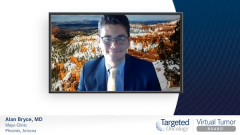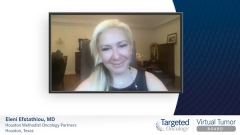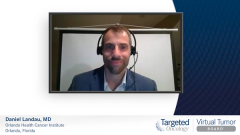
Factors in Selecting Therapy for Nonmetastatic CRPC
Shared insight on how expert oncologists select therapy for patients with nonmetastatic castration-resistant prostate cancer.
Episodes in this series

Transcript:
Alan Bryce, MD: Concerning recommendations for the next line of therapy, Dan, what would you give?
Daniel Landau, MD: We’re going to want to add another agent, androgen blocking agents. Given that this patient has a history of seizures, I’d certainly lean away from certain drugs. Darolutamide, which doesn’t seem to increase seizure risk, is a drug that I’d use most often in this setting.
Alan Bryce, MD: Eleni, I’m sure you agree. We see this stem.
Eleni Efstathiou, MD, PhD: I need to make a full disclosure. You 2 probably know I’ve been involved in the development of apalutamide, enzalutamide, and abiraterone but not darolutamide. This is all I prescribe. I’m sorry. They’re going to hate me when I hear it. Especially for this stage of performance status. They’re doing great. History has seizure disorder. It’s a walk in the park. Your nurse will say, “We’re going for darolutamide.”
Alan Bryce, MD: With this history, there’s no question at all. We’ll go over some of those data in a few slides. It’s always funny to me when they ask, “How important is quality of life?” It’s always important. It’s important with every decision we make every step of the way, without question.
Eleni Efstathiou, MD, PhD: I guess we have a consensus: darolutamide was given. That’s the end of this case.
Alan Bryce, MD: What if the PSA [prostate-specific antigen] doubling time is 15 months? Eleni, you’ve been involved with the development of all these. What do you think?
Eleni Efstathiou, MD, PhD: Fifteen months is a bit of a long PSA doubling time to give a systemic agent, even if it’s super safe. But if there’s no risk to the man, you’re exposing him to another level of systemic treatment. I don’t usually say this, but I’ll say it now: it’s also quite costly. Any of the 3 agents there. We don’t have data to support the PSA doubling time that’s 15 months. I’m with everyone who’s feeling the heat of the patient breathing down your neck when the PSA is going up, but we’ve got to be a little resistant.
Alan Bryce, MD: I completely agree. The point we want to make for the listeners is that all 3 studies were designed around the same criteria of a PSA doubling time of 10 months or faster. The reason for that is the old Matthew Smith data showing that the inflection point at which risk starts to increase is around 8 to 10 months. We saw that in the old…studies. The other point is that when we look at the progression-free survival [PFS] curves from all 3 studies, it’s always important to tell your patient that on the control arm, the PFS was greater than a year. This is a disease state in which nothing happens too quickly. With a PSA doubling time of 15 months or anything greater than 10 months, that rPFS [radiographic PFS] is going to be even longer than the 12 or 13 months we saw in those studies. We always try to turn down the temperature in these patients. Bring that anxiety level down. Nothing is going to happen too quickly. It’s OK.
Eleni Efstathiou, MD, PhD: Absolutely. I try to distract them and do things that are very valid, like look at their bone density, fix their vitamin D levels and things that are needed because they’re already exposed to androgen deprivation.
Transcript edited for clarity.










































